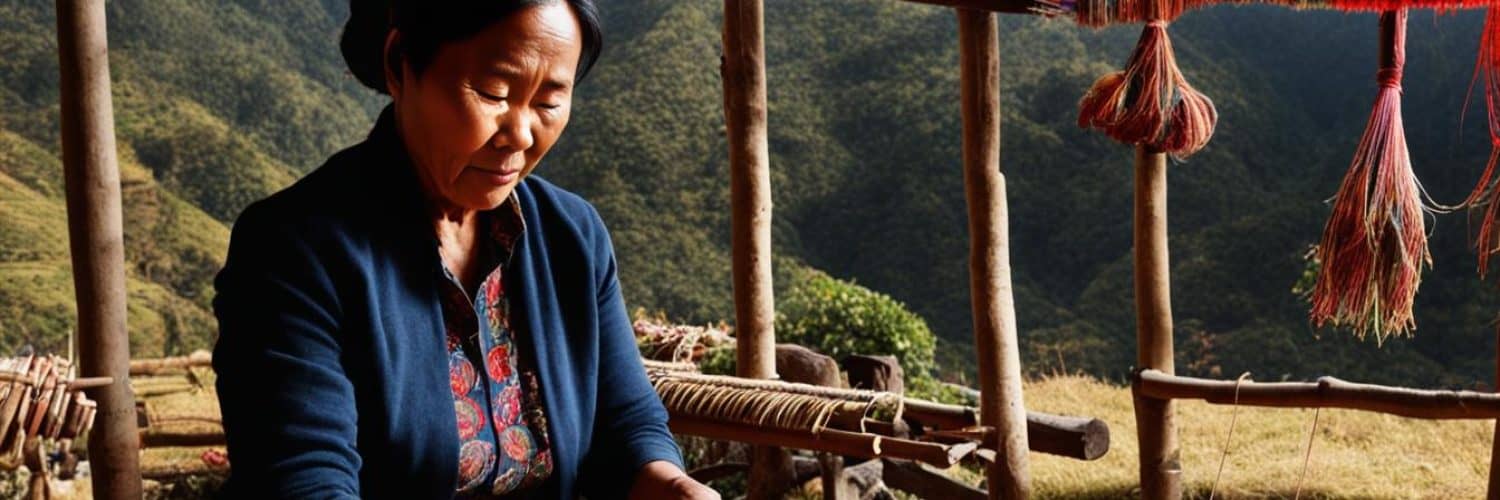Sagada Weaving is a time-honored tradition in the mountain province of Sagada, Philippines. Renowned for its skillful artisans and intricate patterns, this craft is deeply rooted in the cultural heritage of the local community. Handwoven products from Sagada are a testament to authentic craftsmanship and showcase the rich tapestry of indigenous textiles.
At the heart of Sagada Weaving lies a commitment to sustainability. Weavers prioritize using locally sourced materials and natural dyes, ensuring that their practices have a minimal impact on the environment. Through their dedication and expertise, they keep the art of traditional weaving alive, preserving the cultural legacy of Sagada.
Key Takeaways:
- Sagada Weaving is a traditional craft rooted in the cultural heritage of the mountain province of Sagada.
- Handwoven products from Sagada showcase authentic craftsmanship and intricate patterns.
- Sustainability is a core principle of Sagada Weaving, with a focus on using natural dyes and locally sourced materials.
- Sagada Weaving preserves the cultural legacy of the region, passing down traditional weaving techniques to future generations.
- By supporting Sagada Weaving, individuals contribute to the local economy and the preservation of indigenous textiles.
The History of Sagada Weaving
Sagada Weaving is not just a craft but a part of the rich cultural heritage of the region. Its history can be traced back centuries, with traditional weaving techniques being passed down from generation to generation. This art form requires great skill and precision, as the weavers create intricate patterns using their unique weaving techniques.
The textiles produced through Sagada Weaving hold deep cultural significance and are an integral part of traditional rituals and ceremonies. They reflect the community’s way of life and are adorned with symbolic designs and motifs that represent their beliefs, stories, and legends.
Sagada Weaving has played a vital role in preserving the cultural heritage of the Sagada people. It is not only a means of creating beautiful textiles, but also a way to preserve their identity and foster a sense of pride within the community.
Weaving Techniques Passed Down Through Generations
The weaving techniques used in Sagada Weaving are unique to the region. They have been perfected over centuries and require a deep understanding of the craft. The weavers meticulously thread the loom, carefully selecting colors and patterns to create stunning textiles. The process is a testament to the skill, dedication, and expertise of the artisans.
The weavers in Sagada undergo years of training and apprenticeship to master these techniques. They continue to pass down their knowledge to the younger generation, ensuring the preservation of this incredible art form for years to come.
Cultural Significance in Traditional Rituals and Ceremonies
Sagada Weaving holds immense cultural significance in the community. The textiles produced are not just meant for everyday use, but are also an integral part of traditional rituals and ceremonies. They are woven with intention and purpose, reflecting the spiritual beliefs and cultural practices of the Sagada people.
During important occasions such as weddings, festivals, and rites of passage, handwoven textiles are prominently featured and worn by the community members. They serve as a visual representation of their cultural identity and connect them to their ancestors and traditions.
The Process of Sagada Weaving
Sagada Weaving is a meticulous and labor-intensive process that involves several steps, resulting in the creation of exquisite handwoven textiles. From the sourcing of raw materials to the intricate weaving techniques and the use of natural dyes, every aspect of the process contributes to the authenticity and beauty of Sagada Weaving.
1. Sourcing Raw Materials:
The first step in the Sagada Weaving process is gathering natural fibers to create the base material for the textiles. Locally sourced cotton and abaca fibers are carefully selected for their quality and strength. These fibers provide a durable foundation for the handwoven textiles.
2. Hand Weaving on Traditional Looms:
Once the raw materials are collected, skilled artisans use traditional looms to meticulously weave intricate patterns and designs. The weaving is done by hand, ensuring precision and attention to detail in every stitch. The technique requires years of practice and expertise to achieve the desired result.
3. Natural Dyeing:
To add vibrant colors to the textiles, natural dyes made from plants and herbs are used. These dyes not only create beautiful hues but also contribute to the sustainability of Sagada Weaving. The use of natural dyes aligns with the community’s commitment to preserving their cultural heritage and the environment.
4. Finishing Touches:
Once the weaving and dyeing process is complete, the textiles undergo finishing touches. These include trimming loose threads, adjusting the fabric’s dimensions, and adding any additional embellishments or decorative elements.
Through the meticulous and time-honored process of Sagada Weaving, artisans create handwoven textiles that are not only visually stunning but also carry the cultural significance and authenticity that have been passed down through generations.
Sagada Weaving Process Steps and Highlights
| Step | Highlights |
|---|---|
| Sourcing Raw Materials | – Locally sourced cotton and abaca fibers – High-quality and durable materials |
| Hand Weaving on Traditional Looms | – Intricate patterns and designs – Meticulous attention to detail |
| Natural Dyeing | – Use of natural dyes made from plants and herbs – Vibrant and eco-friendly colors |
| Finishing Touches | – Trimming loose threads – Adjusting dimensions – Adding embellishments |
Traditional Patterns and Designs
The textiles produced through Sagada Weaving are adorned with traditional patterns and designs. These patterns often have deep cultural and symbolic meanings, representing the community’s way of life. Some designs feature motifs inspired by nature, while others depict stories and legends passed down through generations. Each piece of handwoven textile tells a unique story and is a reflection of the rich heritage of Sagada.
Symbolic designs and cultural motifs play a significant role in Sagada Weaving, showcasing the community’s connection to their traditions and beliefs. The intricate patterns intricately woven into the fabrics are not only visually stunning but also carry profound meaning.
For example, the “Inabel” patterns, characterized by geometric shapes and lines, represent the harmony and balance in life. They symbolize the community’s belief in the interconnection between nature and human existence. These designs can be seen in various textiles, such as blankets, scarves, and clothing.
An essential aspect of Sagada Weaving is the use of cultural motifs that depict stories and legends passed down through generations. These motifs serve as a means of preserving and honoring the community’s history and traditions. They often depict significant events, mythical creatures, or ancestral heroes.
“The motifs and patterns of Sagada Weaving are like chapters of our community’s storybook. Each design tells a tale, preserving our cultural heritage and passing it on to future generations,” says Ana Reyes, a master weaver in Sagada.
Some of the popular cultural motifs in Sagada Weaving include:
- The “Butterfly” motif symbolizes transformation, renewal, and freedom.
- The “Mountaintop” motif represents strength, resilience, and overcoming challenges.
- The “Sun and Moon” motif signifies the balance of opposites and the cyclical nature of life.
- The “Rice Terraces” motif depicts the community’s deep connection to farming and their reverence for nature’s bounty.
These traditional patterns and designs not only add visual beauty to the handwoven textiles but also serve as a celebration of Sagada’s cultural identity and a showcase of the community’s artistic skills and creativity.
| Traditional Patterns and Designs | Description |
|---|---|
| Inabel Patterns | Geometric shapes and lines representing harmony and balance. |
| Butterfly | Symbolizes transformation, renewal, and freedom. |
| Mountaintop | Represents strength, resilience, and overcoming challenges. |
| Sun and Moon | Signifies the balance of opposites and the cyclical nature of life. |
| Rice Terraces | Depicts the community’s deep connection to farming and reverence for nature’s bounty. |
Weaving Workshops in Sagada
Sagada offers weaving workshops for those interested in learning the art of traditional weaving. These workshops provide a hands-on experience, allowing participants to learn the weaving techniques directly from skilled artisans. Participants get to immerse themselves in the rich culture and heritage of Sagada while creating their own handwoven textiles. The weaving workshops in Sagada are a great opportunity to connect with the local community and gain a deeper appreciation for this ancient craft.
During the weaving workshops, participants will have the chance to learn the intricate weaving techniques that have been passed down through generations. They will be guided by experienced weavers who will teach them the traditional methods of creating beautiful textiles. Through this hands-on experience, participants will not only acquire new skills but also gain a deeper understanding of the cultural significance behind Sagada weaving.
These workshops offer a unique opportunity to connect with the local community and learn directly from the artisans who have dedicated their lives to honing their craft. Participants will have the chance to engage with the weavers, ask questions, and hear stories that have been passed down through generations. It’s a truly immersive experience that allows individuals to appreciate the artistry and skill behind each handwoven piece.
Whether you’re a beginner or already have some experience in weaving, these workshops cater to all skill levels. Participants will receive personalized instruction and guidance from the skilled artisans, ensuring that they gain valuable knowledge and hands-on experience in Sagada weaving. By the end of the workshop, participants will not only take home their own handcrafted textile but also a newfound appreciation for the intricate art of traditional weaving.
Don’t miss out on this incredible opportunity to immerse yourself in the world of Sagada weaving and learn from the talented artisans who carry on this ancient craft. Sign up for a weaving workshop in Sagada today and embark on a journey of cultural exploration and hands-on creativity.
| Benefits of Weaving Workshops in Sagada | What to Expect in a Weaving Workshop |
|---|---|
|
|
Sustainable Weaving Practices
In the world of Sagada Weaving, sustainability is a key pillar that drives the artisans’ commitment to preserving the environment and supporting local communities. Through the use of natural dyes and locally sourced materials, Sagada Weaving embraces eco-friendly practices that not only minimize the environmental impact but also contribute to the preservation of the region’s cultural heritage.
One of the sustainable practices adopted by Sagada weavers is the use of natural dyes made from plants and herbs. These natural dyes not only produce vibrant and beautiful colors, but they also eliminate the need for harmful chemical dyes that can pollute water sources and harm the ecosystem. By utilizing these natural alternatives, Sagada Weaving combines artistic expression with responsible environmental stewardship.
Furthermore, the weavers in Sagada prioritize sourcing their materials locally, supporting the livelihoods of local farmers and preserving traditional farming practices. By using locally sourced materials such as cotton and abaca fibers, Sagada Weaving strengthens the bond between the artisans and their community, ensuring the sustainability of the craft for future generations.
“Sagada Weaving is more than just a craft; it is an embodiment of our commitment to sustainability and preserving our cultural heritage. By using natural dyes and locally sourced materials, we not only create beautiful handwoven textiles but also contribute to the well-being of our environment and community,” says Maria Santos, a master weaver in Sagada.
Sagada Weaving’s dedication to sustainable practices also extends to the way they manage waste. Leftover materials and scraps are repurposed or composted, minimizing waste sent to landfills and promoting a circular economy mindset within the weaving community.
Through sustainable weaving practices, Sagada Weaving sets an example for the global textile industry, showcasing the possibilities of creating beautiful and authentic products while minimizing environmental harm. By choosing handwoven textiles from Sagada, individuals can not only support local artisans but also contribute to a more sustainable and responsible future.
The Cultural Heritage of Sagada Weaving
Sagada Weaving holds a special place in the preservation of the cultural heritage of the region. It is not merely a craft but a testament to the resilience and creativity of the people of Sagada. Through this art form, indigenous textiles and traditional weaving techniques that have been passed down through generations are brought to life, showcasing the rich cultural identity of the community.
The art of Sagada Weaving serves as a way to foster a sense of pride within the community, as it embodies their cultural heritage. The intricately woven textiles carry the stories, symbols, and motifs that are deeply rooted in the traditions and rituals of the region. Each piece of handwoven textile tells a unique story, representing the values, beliefs, and history of the Sagada people.
“Sagada Weaving not only showcases the cultural heritage of the community but also provides a platform for cultural preservation and appreciation. It is a means of keeping the traditions alive and connecting the present generation to its ancestral roots.”
The indigenous textiles created through Sagada Weaving are not only visually captivating but also hold a deeper significance. The traditional patterns and designs reflect the relationship between the community and their natural surroundings, often depicting elements of nature and local legends. These textiles serve as a tangible expression of the cultural identity and a way to pass on the traditions to future generations.
To fully appreciate the cultural heritage of Sagada Weaving, one must understand the dedication and skill required to create these handwoven textiles. The weaving techniques have been honed over centuries, with each generation adding their own touch of creativity and innovation. The commitment to preserving these techniques is a testament to the cultural pride and commitment of the Sagada community.
By supporting Sagada Weaving and embracing the indigenous textiles, individuals contribute to the cultural preservation of the region. The continued patronage of these handcrafted products helps sustain the weaving traditions and provides economic opportunities for the local artisans. Furthermore, it fosters a deeper understanding and appreciation of the cultural heritage of Sagada, making a positive impact on the community and ensuring the legacy of Sagada Weaving for generations to come.
Examples of Traditional Designs and Patterns
| Traditional Design | Meaning |
|---|---|
| The intertwining lines symbolize the interconnectedness of the Sagada community and their harmonious relationship with nature. | |
| The spiral motif represents the cyclical nature of life and the eternal connection between past, present, and future. | |
| The diamond pattern signifies protection and blessings, reflecting the community’s hope for a prosperous and harmonious life. |
The Significance of Authentic Craftsmanship
Authentic craftsmanship lies at the heart of Sagada Weaving. Each textile is meticulously handwoven, showcasing the skill, expertise, and artisanal skills of the local weavers. The attention to detail and the dedication invested in creating every piece distinguish Sagada Weaving from mass-produced textiles.
By supporting authentic craftsmanship, not only do you acquire a unique and high-quality handmade product, but you also become a patron of the local community and contribute to the preservation of their cultural heritage.
“Sagada Weaving is a true testament to the passion and artistry of the artisans. It is remarkable to witness the skillful craftsmanship that goes into every handwoven textile. The love and dedication poured into each creation make these products truly special and cherished by those who appreciate the value of authentic craftsmanship.” – Sarah Thompson, Textile enthusiast
The Uniqueness of Handmade Products
Handmade products hold a certain charm and individuality that cannot be replicated by mass-produced items. When you buy a handwoven textile from Sagada, you are acquiring a one-of-a-kind piece with its own story and character. The subtle imperfections and human touch present in handmade products make them truly exceptional.
Furthermore, handmade products contribute to a more sustainable and ethical consumption pattern, promoting slow fashion and responsible manufacturing practices. By choosing authentic craftsmanship, you are supporting artisans and their livelihoods, fostering creativity, and valuing the preservation of traditional artisanal skills.
The Artisanal Skills of Sagada Weavers
Sagada Weaving is a true testament to the artisanal skills passed down through generations. The weavers possess a deep understanding of traditional techniques and a profound connection to the cultural significance of their craft. Through years of practice and dedication, they master the intricate weaving patterns and bring them to life on their looms.
These artisans possess an intimate knowledge of locally sourced materials, allowing them to create textiles that are not only visually captivating but also sustainable. Their expertise in utilizing natural dyes and fibers ensures that each product is eco-friendly and in harmony with the environment.
The Value of Cultural Heritage
Sagada Weaving goes beyond the creation of beautiful textiles; it embodies the cultural heritage and identity of the local community. Each handwoven piece carries the stories, traditions, and symbolism woven into its intricate patterns. By supporting Sagada Weaving, you become a part of the rich tapestry that preserves cultural traditions and celebrates the diversity of indigenous textiles.
By embracing authentic craftsmanship and choosing handmade products, we acknowledge and honor the invaluable role artisans play in shaping our cultural landscape. Let us cherish and support the artisans of Sagada Weaving, who continue to weave the threads of tradition and inspire us with their artistic mastery.
| Benefits of Authentic Craftsmanship | Reasons to Choose Handmade |
|---|---|
| Unique and one-of-a-kind products | Supports local artisans and their livelihoods |
| Showcases artisanal skills and expertise | Promotes sustainable and ethical consumption |
| Preserves cultural heritage and traditions | Values the human touch and individuality |
| Contributes to slow fashion and responsible manufacturing | Helps foster creativity and craftsmanship |
The Impact of Sagada Weaving
Sagada Weaving has a significant impact on the local economy and community, providing both economic support and cultural preservation. By purchasing handwoven products from Sagada, individuals directly contribute to the well-being of the local community and help preserve their cultural heritage.
The economic impact of Sagada Weaving is substantial as it provides livelihood support to the weavers. Through their craft, the weavers are empowered to earn a sustainable income, supporting themselves and their families. This economic stability enables the weavers to continue practicing their traditional art form and preserve their cultural identity.
Sagada Weaving also plays a vital role in cultural preservation. By keeping traditional weaving techniques and indigenous textiles relevant in the modern world, the art form ensures the continuity of centuries-old traditions. The intricate patterns and designs produced through Sagada Weaving represent a rich cultural heritage that holds deep significance for the community.
By supporting Sagada Weaving, individuals become an active participant in the cultural preservation of the Sagada community and its traditions. This support helps sustain the livelihoods of the weavers, empowering them to continue practicing their craft and passing down their knowledge to future generations.
In conclusion, Sagada Weaving has a positive economic impact by providing livelihood support and empowers the weavers to earn a sustainable income. Additionally, the art form contributes to cultural preservation by keeping traditional weaving techniques and indigenous textiles relevant. By purchasing handwoven products from Sagada, individuals directly support the local community and help preserve their cultural heritage.
Where to Find Sagada Weaving Products
If you’re looking to purchase authentic Sagada Weaving products, you have several options available, both online and offline. Whether you prefer the convenience of shopping from online stores or enjoy the experience of browsing through local markets, there are numerous avenues to explore.
Online Stores
Online stores specializing in handmade products offer a wide selection of handwoven textiles from Sagada. These platforms provide a convenient way to browse through different products and make a purchase from the comfort of your own home. You can easily find websites that curate traditional crafts from various regions, including Sagada Weaving. Simply search for keywords like “Sagada Weaving” or “handwoven textiles” to discover reliable online stores that offer these exquisite products.
When purchasing from online stores, it’s important to read product descriptions, look for authentic certification, and check customer reviews to ensure the quality and authenticity of the Sagada Weaving products.
Local Markets
If you prefer a more immersive shopping experience, visiting local markets in the mountain province of Sagada itself is an excellent option. These markets offer a vibrant and traditional setting where you can directly interact with the local artisans and witness the weaving process firsthand. It’s a unique opportunity to appreciate the craftsmanship and select from a wide range of authentic Sagada Weaving products.
When visiting local markets, it’s advisable to engage in friendly conversations with the weavers and learn more about the cultural significance behind each textile. This personal connection adds depth to your purchase and allows you to support the local community directly.
| Where to Find Sagada Weaving Products: | Shopping Experience: |
|---|---|
| Online Stores | Convenient and accessible from anywhere |
| Local Markets | Immersive experience, direct interaction with artisans |
By exploring online stores and local markets, you can easily find and purchase these exquisite handcrafted textiles. Whether you choose the convenience of online shopping or the authenticity of local markets, each purchase directly supports the weavers of Sagada and helps preserve their cultural heritage.
Conclusion
Sagada Weaving is a beautiful art form that not only produces exquisite handwoven textiles but also preserves the rich cultural heritage of the Sagada community. The intricate patterns and designs, created using traditional weaving techniques, are a testament to the authentic craftsmanship and skill of the local artisans.
The use of natural dyes made from plants and herbs adds vibrant colors to the textiles, while also promoting sustainable practices. By supporting Sagada Weaving, individuals not only acquire unique and authentic handcrafted products but also play a crucial role in preserving the local culture and empowering the weavers.
Sagada Weaving reflects the beauty and craftsmanship of indigenous textiles, telling stories, and symbolizing the way of life in the region. Through their creations, the weavers keep the cultural identity alive and foster a sense of pride within the community. Sagada Weaving is more than just a craft; it is a living heritage that deserves recognition and appreciation.
FAQ
What is Sagada Weaving?
Sagada Weaving is a traditional craft in the mountain province of Sagada, known for its authentic handwoven products and intricate patterns.
What makes Sagada Weaving unique?
Sagada Weaving is unique due to its traditional weaving techniques that have been passed down through generations, preserving the cultural heritage of the region.
What materials are used in Sagada Weaving?
The weavers in Sagada use natural fibers like cotton and abaca to create the base material for their textiles.
How are the patterns and designs created in Sagada Weaving?
The patterns and designs in Sagada Weaving are created using traditional looms and intricate hand-weaving techniques.
Are the dyes used in Sagada Weaving natural?
Yes, the weavers in Sagada use natural dyes made from plants and herbs to add vibrant colors to their textiles.
Can I learn Sagada Weaving through workshops?
Yes, Sagada offers weaving workshops where participants can learn the art of traditional weaving directly from skilled artisans.
How does Sagada Weaving contribute to sustainability?
Sagada Weaving adopts sustainable practices by using natural dyes and locally sourced materials, reducing environmental impact.
What is the cultural significance of Sagada Weaving?
Sagada Weaving plays a significant role in preserving the cultural heritage of the region and represents the indigenous textiles and traditional weaving techniques.
What is the importance of authentic craftsmanship in Sagada Weaving?
Authentic craftsmanship is showcased in Sagada Weaving, highlighting the skill, dedication, and attention to detail of the artisans.
How does Sagada Weaving impact the local community?
Sagada Weaving provides livelihood support to local weavers, contributes to the local economy, and helps preserve traditional weaving techniques and cultural heritage.
Where can I find Sagada Weaving products?
Sagada Weaving products can be found online through various handmade product stores and in local markets in the mountain province of Sagada.


















Add comment